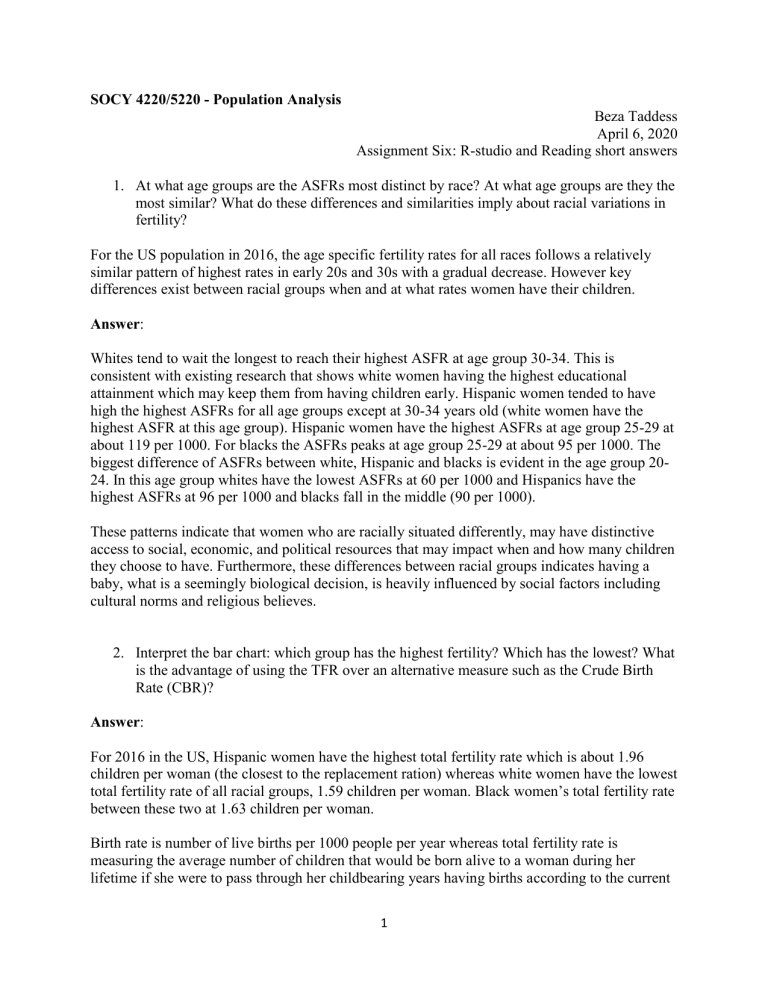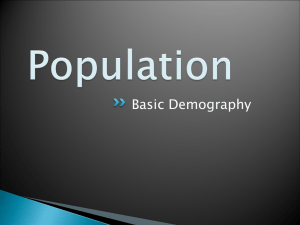
SOCY 4220/5220 - Population Analysis Beza Taddess April 6, 2020 Assignment Six: R-studio and Reading short answers 1. At what age groups are the ASFRs most distinct by race? At what age groups are they the most similar? What do these differences and similarities imply about racial variations in fertility? For the US population in 2016, the age specific fertility rates for all races follows a relatively similar pattern of highest rates in early 20s and 30s with a gradual decrease. However key differences exist between racial groups when and at what rates women have their children. Answer: Whites tend to wait the longest to reach their highest ASFR at age group 30-34. This is consistent with existing research that shows white women having the highest educational attainment which may keep them from having children early. Hispanic women tended to have high the highest ASFRs for all age groups except at 30-34 years old (white women have the highest ASFR at this age group). Hispanic women have the highest ASFRs at age group 25-29 at about 119 per 1000. For blacks the ASFRs peaks at age group 25-29 at about 95 per 1000. The biggest difference of ASFRs between white, Hispanic and blacks is evident in the age group 2024. In this age group whites have the lowest ASFRs at 60 per 1000 and Hispanics have the highest ASFRs at 96 per 1000 and blacks fall in the middle (90 per 1000). These patterns indicate that women who are racially situated differently, may have distinctive access to social, economic, and political resources that may impact when and how many children they choose to have. Furthermore, these differences between racial groups indicates having a baby, what is a seemingly biological decision, is heavily influenced by social factors including cultural norms and religious believes. 2. Interpret the bar chart: which group has the highest fertility? Which has the lowest? What is the advantage of using the TFR over an alternative measure such as the Crude Birth Rate (CBR)? Answer: For 2016 in the US, Hispanic women have the highest total fertility rate which is about 1.96 children per woman (the closest to the replacement ration) whereas white women have the lowest total fertility rate of all racial groups, 1.59 children per woman. Black women’s total fertility rate between these two at 1.63 children per woman. Birth rate is number of live births per 1000 people per year whereas total fertility rate is measuring the average number of children that would be born alive to a woman during her lifetime if she were to pass through her childbearing years having births according to the current 1 schedule of age-specific fertility rates. The total fertility rate gives us information about the growth of population. In other words, the total fertility rate is a more refined way to measure fertility than crude birth rate because the fertility rate accounts for the percentage of women aged 15 to 49 years in a population. Despite this, differences in fertility rates may be due to differences in the percentage of women in the most fertile age groups (25-34 years) in different populations. Respond to the following questions based on assigned readings: 1. Fertility declined considerably between the 19th and 20th centuries in most developed nations. What are two reasons that have been offered to explain these declines? Answer: Social scientists have proposed several possible theories that aim to explain fertility decline for most developed nations between the 19th and 20th centuries. For example, Willis (1973) indicated that the increased participation of women in the labor market as a result the industrial revolution market may have lowered fertility. Adding on to this theory of economic perspective, Becker (1991) argues that parents shift to raising “quality” children with more educational investment may have contributed to a decline in fertility. As global mortality decreased as a result of increased access to food and general health and hygiene, the demand for more children decreases, giving way to ‘quality’ children who will have potential for higher educational and income attainment. Another possible reason for the global decline in fertility is innovation in new and effective contraceptive and behavior diffusion of utilizing these contraceptives (Caldwell and Thomas 2003). This perspective argues that it is not the change in the ‘prize’ of children that motivated smaller families, but rather the change in behaviors and access to financially cheap and effective methods of birth control. 2. Peter McDonald has offered some reasons why fertility is, and will remain, low in countries like the United States. In 3-4 sentences per reading, explain what these reasons are. Reflecting on your own life and those around you, do you find merit in McDonald’s arguments regarding the link between fertility and the asymmetry in gender equity within public versus private institutions? Why or why not? Answer: McDonald argued that the low fertility in advanced countries is the outcome of inconsistency between high levels of gender equity in individual-oriented social institutions and sustained gender inequity in family-oriented social institutions. He argues, women who have been discriminated against based on gender, have been gaining equity in individual-orientated social institutions such as the labor market. Thus, this gender equity has allowed women to control the number of children they have, resulting in low fertility rate in developed counties. This sustained low fertility then goes to fundamentally alter women’s lives. This is especially evident of the fact that high fertility rates are not naturally determined but socially determined. If this individualorientation towards gender equity then moved towards to also include family-oriented 2 institutions, the fertility rate lowers further. Therefore, industrialized countries such as the US will continue to see low fertility rate. This is very much evident in my workplace. The women I work with are women who benefit from the individualized-oriented gender equity, yet they bare most of the public responsibility of their family life including who takes care of the household as well as it the primary caregivers for their children. Furthermore, they are the primary caregivers for their parent-in-laws as well as their aging parents. 3. In the US, fertility outcomes differ considerably by race. Drawing on the reading by Forste and Tienda, briefly summarize the ways in which fertility outcomes vary by race and the reasons the authors provide for these disparities. Answer: Forste and Tienda (1996) argue reasons that explain the fertility rate differences by the race and ethnic are complex and multidimensional. They argue that simple “cultural” difference between race does not fully explain the variation of fertility between racial groups. They highlight how all racial and ethnic groups experience early childbearing, non-marital fertility and large families. However, what explains these similarities is different between groups and changes over time. They argue, for example, patterns of Hispanic and Black fertility are different for both groups. They show how family background, community involvement and consumption of media all impact the hierarchical structure of early childbearing for both racial groups differently. Depending on how these factors affect role models, which are different for all racial and ethnic groups, could also in turn, affect the childbearing timeline, perception and goals. Another possible mechanism how belonging to different racial or ethnic groups could impact fertility that Forste and Tienda (1996) explore is the timing of the first births. They illustrate how blacks tend to have children outside of marriage in higher proportion that whites, only 7 percent of all Asian births were to unmarried mothers, compared to 27 percent to unmarried Hispanic women and 67 percent to black unmarried mothers. These differences could be because there maybe weak connection between nuptiality and fertility, implying that there are differences in how each racial group creates meaning and value around marriage relative to childbearing. Overall, they call for in-depth unpacking of the machines that result in similar patterns of sustain early childbearing, nonmarital fertility, and large families that are shared by non-white racial groups including a study over time. 3




